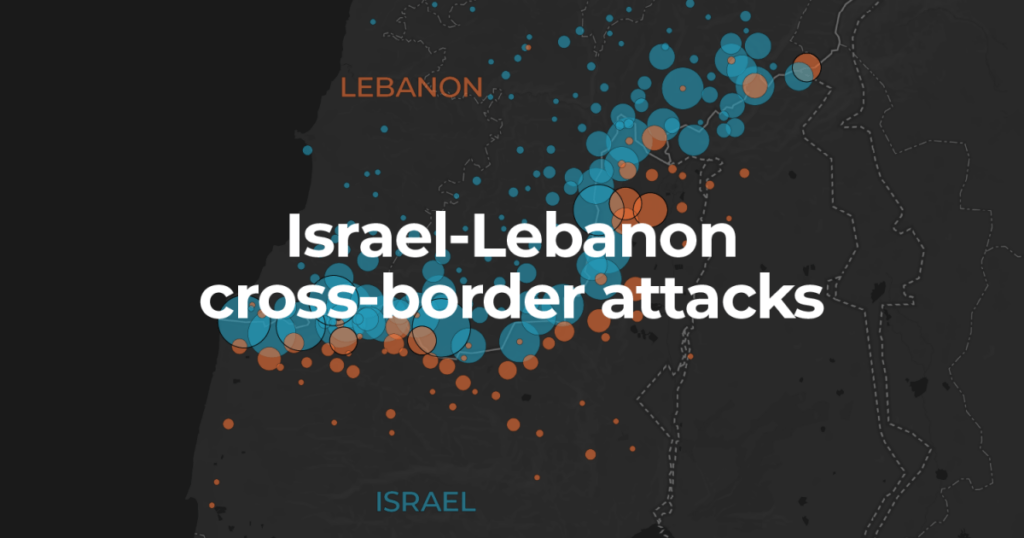Israeli-Lebanese Cross-Border Attacks Mapped
Israel has been engaged in a prolonged conflict with Gaza for seven months, but just a few hours north, another conflict along the border with Lebanon has been escalating, posing a risk of a broader regional war. The hostilities began on October 8 when Hezbollah, a Lebanese Shia armed group and political party with backing from Iran, launched attacks on Israel in solidarity with the Palestinians. Since then, Israel has retaliated with nearly 4,000 attacks along the 120km border.
Hezbollah was established in 1982 to resist Israel’s invasion and occupation of southern Lebanon. In the 2006 war, Hezbollah fought Israel for 34 days, which was considered a strategic failure for Israel. While Hezbollah’s leader, Hassan Nasrallah, has not declared an all-out war against Israel, he has made it clear that his forces are prepared to engage in one. Hezbollah has vowed to continue its military operations against Israel until the assault on Gaza ceases. In response, Israeli leaders have promised to remove Hezbollah from southern Lebanon, even if it requires the use of force.
According to the Armed Conflict Location and Event Data Project (ACLED), there have been a total of 4,733 attacks exchanged between Israel, Hezbollah, and other armed groups in Lebanon from October 7, 2023 to March 15, 2024. Israel conducted approximately 83% of these attacks, totaling 3,952 incidents, while Hezbollah and other groups were responsible for 781 attacks. The attacks included artillery or missile strikes, air or drone strikes, armed clashes, destruction of property, and the use of explosives.
Apart from Hezbollah, other groups involved in attacks against Israel include the Lebanese al-Fajr Forces, Amal Movement, Hamas’s Qassam Brigades, and Islamic Jihad’s al-Quds Brigades. The most targeted locations in southern Lebanon by Israel include Aita al-Shaab, Ras al-Naqoura, Houla, Tayr Harfa, and Alma ash-Shaab. In northern Israel, Kiryat Shmona, Margaliyot, Shetula, Shebaa Farms, and Aramsha were the most frequently attacked areas by Lebanese groups.
The timeline of attacks reveals a pattern of ongoing violence. Israeli jets and drones have carried out strikes across Lebanon and even in Syria with minimal repercussions. Hezbollah and other armed groups have averaged five attacks on Israel daily, while Israel has responded with about 25 attacks on Lebanon daily. The conflict has resulted in casualties on both sides, with hundreds of fighters and civilians losing their lives.
The International Organization for Migration (IOM) reported that over 90,000 people have been displaced due to the fighting in southern Lebanon. The majority of these displaced individuals come from areas along the southern border, with many homes and infrastructure destroyed by Israeli attacks. On the Israeli side, residents in towns near the border have been instructed to evacuate for safety.
Both Israel and Hezbollah possess advanced weaponry, including missiles and drones. Israel’s arsenal is considered the most sophisticated in the Middle East, with a significant portion of its weapons supplied by the United States. Hezbollah, on the other hand, is known for its extensive rocket arsenal, capable of reaching deep into Israeli territory.
The ongoing conflict between Israel and Lebanon, particularly with Hezbollah’s involvement, remains a volatile situation that could potentially escalate into a wider regional conflict. The mapping of cross-border attacks provides valuable insights into the dynamics of this complex and dangerous situation.
#Mapping #IsraelLebanon #crossborder #attacks
The ongoing cross-border attacks between Israel and Lebanon have significant long-term implications for the region and could potentially lead to a wider regional conflict. The key points from the article highlight the intensity of the attacks, the casualties on both sides, the displacement of tens of thousands of people, and the sophisticated arsenals of both Israel and Hezbollah.
The attacks have resulted in hundreds of deaths, including fighters from Hezbollah and other armed groups in Lebanon, as well as civilians, children, medics, and journalists. The displacement of over 90,000 people in southern Lebanon and the destruction of housing units, infrastructure, and vehicles demonstrate the devastating impact of the conflict on the civilian population.
Israel’s advanced missile capabilities, including precision-guided missiles from the United States and a robust integrated air defense system, pose a significant threat to Hezbollah and other armed groups in Lebanon. On the other hand, Hezbollah’s arsenal of rockets and missiles, estimated to contain 130,000 pieces, presents a formidable challenge to Israel’s security.
In light of these developments, it is crucial to consider the long-term implications and possible future developments of the conflict. The continued escalation of attacks, the high number of casualties, and the displacement of civilians underscore the urgent need for a diplomatic solution to prevent further loss of life and destruction.
Actionable advice based on these insights includes advocating for a ceasefire, promoting dialogue and negotiations between Israel and Lebanon, and calling for international intervention to facilitate peace talks. Additionally, addressing the root causes of the conflict, such as territorial disputes, political tensions, and historical grievances, is essential for achieving a sustainable peace in the region.
Overall, the situation between Israel and Lebanon requires a comprehensive and coordinated approach to de-escalate tensions, protect civilians, and promote stability in the region. By addressing the underlying issues and working towards a peaceful resolution, the international community can help prevent further violence and pave the way for a more secure and prosperous future for all parties involved.

